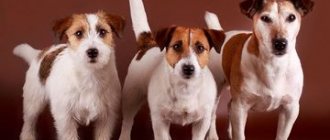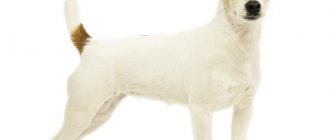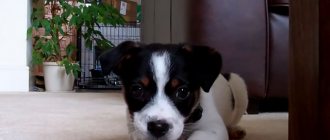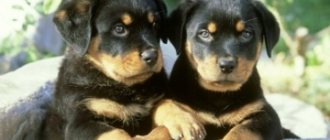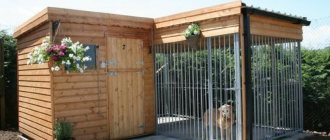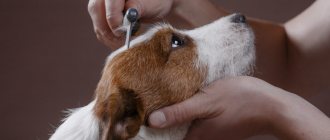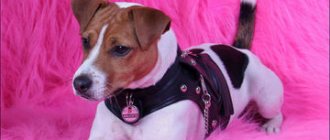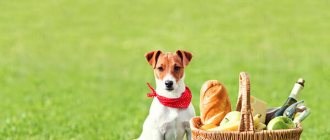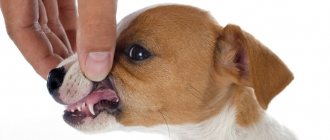The family has a long-awaited little friend - a puppy. And with him comes the pleasant chores of arranging his life and upbringing. One of the first questions that arises is how to toilet train a puppy. While he is small, it is expected that he will not ask to go outside, and the useful information in this article will help to eliminate unpleasant “surprises” on the floor or carpet.
Principles of raising a puppy
Puppy training follows the principle “from simple to complex.” If a simple command is poorly understood, then the owner should not move on to a more complicated option. The puppy is not given a whole combination of words at once. All activities should not physically tire your pet. You cannot demand actions that are obviously impossible from him.
Commands are given clearly and always in the same intonation. Dogs primarily respond to human intonation. Commands are given in one word. You cannot tell your pet to “lie down!”, and then abruptly “lie down!”. When working, unnecessary expressions are unacceptable, such as “lie down, not sit, I said!” The puppy will not understand the owner's requirements and will be confused, as he will receive two different commands at once. Seeing a person’s dissatisfaction and nervousness, the pet itself will become anxious. He will not understand what they want from him and will see that the owner is annoyed with him.
Accustoming to equipment at home
Before the first walk, the puppy must be accustomed to a collar and leash. This will take several days and the owner's patience. A leash is an important attribute of a dog owner. It serves as a means of control and as a means of conveying information to the dog.
The puppy is first introduced to the leash. First, he is shown an object, but at the same time his attention is concentrated on a treat or game. Sometimes the ammunition is simply placed near the bedding or bowl for a while. Thus, the pet understands that the leash does not pose a serious danger.
Next, carefully fasten the collar on the pet. In most cases, the puppy's reaction is expressed by complete disobedience and attempts to get rid of the foreign object. To prevent this from happening, he is distracted with a toy or treat.
If the pet responds adequately to the collar and leash, it is left fastened for some time, but with the possibility of freedom of action. The first time, the equipment is left on the puppy for a few minutes. Every day this time gradually increases.
At home, it is recommended to walk around with your pet on a leash a little so that he begins to get used to the fact that his actions are controlled. He is not given complete freedom. On the first walk, the principle is the same - control of the pet without concessions. Any wrong action can lead to the development of destructive behavior and disobedience on the street.
How to toilet train
After starting to walk the puppy, they immediately begin to teach him how to go to the toilet outside. Now he is prohibited from relieving himself in the house and this must be stopped immediately. The puppy is walked immediately after feeding and waking up from sleep. This way the training will be much more effective. After each need to be relieved on the street, the pet should be immediately praised. By the age of one year, walks are reduced to 2-3 times a day. Accustomed to regular walks, the pet will, if necessary, let the owner know about the desire to relieve itself.
Often, the owner is faced with the fact that the puppy is walking along the street, but at home he immediately goes to the toilet. He is immediately punished and given the command “fu!” To prevent this from happening again, the walking time should be increased. In addition, the owner must control the dog’s actions, because before relieving himself, the pet begins to spin around in search of a suitable place.
Feeding
Use a bowl with a stand where you can adjust the height. Do not leave uneaten food. Avoid overeating; Russells are prone to obesity. Give food either 2-3 hours before the walk, or after 30 minutes. after her. Terriers are very active; running with a full stomach is harmful for them. The frequency of feeding depends on age:
- up to 4 months — 4-5 times a day
- from 6 months - 3 meals a day
- from 9 months - 2 r/day
- after a year - 1 time per day.
Ready food
SuperPremium food is recommended (for puppies, then for adults). As a rule, such food does not contain grains, which can cause indigestion and allergies. Popular brands:
- Artemis Maximal Dog. The base is chicken, the additives are vegetables, cream, vitamins, iron, calcium. Ingredients: meat, vegetables, fruits.
- Innova EVO. The basis is poultry meat, additives are B vitamins. Ingredients: all types of meat, fish, eggs, herbal ingredients. Includes 4 types of meat, fish, rice, vitamins, fatty acids.
- It is better to take food from the premium, super-premium category or holistic (Royal Canin, Hills, Bosch, Artemis, Chicken Soup, etc.)
Natural feeding
Basic Rules:
75% of the diet should be meat for a puppy and 60% for an adult; the remaining 25% (40%) includes milk, vegetables, and cereals. Fruits are possible, but this is not the basis; fatty meat is not allowed; You need to feed either ready-made dry/wet food or natural food - you cannot mix it (for example, as some people mix wet canned food with porridge); Meat and offal are only thermally processed; Bones are prohibited, except for large bones, which help change teeth and strengthen jaws; Fish once a week and only sea fish - necessarily without bones, no more than 2/3 of the total portion for feeding; By-products are given from 4 months, boiled - before then, all the useful things from them will not be absorbed (this is important for the gastrointestinal tract); Eggs produce only yolks; the whites are hard on the stomach for these dogs; If the dog is domestic, the only activities are walks and active games - the total amount of food should be no more than 4-6% of the dog’s weight. If it’s more, she’ll start to get fat.
10% is allowed only for puppies in the first months of life. If an adult dog is used to the maximum as a hunting dog, the diet can also be slightly increased; It is better to take artificial food from premium, super-premium or holistic (Royal Canin, Hills, Bosch, Artemis, Chicken Soup, etc.) Dairy products: up to 4 months whole milk, then it is better to switch to sour milk; - Potatoes are not prohibited, they are allowed, but very rarely. Excess calcium sometimes causes Russells' ears to stand up; this will be a disadvantage at an exhibition. Give your dog rye crackers and special biscuits that clean his teeth and strengthen his gums. Do not train your pet to beg for pieces from the table. The bowl should always be filled with fresh water.
Puppies
Diet composition: ¾ - meat and dairy products, ¼ - vegetables and grains. The daily food intake should not exceed 10% of the puppy’s weight. You can’t overfeed, as this leads to problems with bone formation. The food should be warm, the consistency like thick sour cream. To improve the process of changing teeth, start giving solid food from 5 months of age. What to feed your puppy:
- boiled chicken, beef, mixed with porridge, vegetables - daily;
- fermented milk products (kefir, bifidok, fermented baked milk, cottage cheese, a slice of cheese) - daily:
- porridge (buckwheat, rice) – daily;
- vegetables (zucchini, carrots, beets), boiled or raw, mixed with sour cream or vegetable oil - daily;
- fruits are possible (apples, pears, bananas), but not often;
- greens (parsley, spinach, dill), finely chopped, mixed with food;
- boiled sea fish without bones - once a week;
- boiled offal (udder, stomachs, liver) – up to 2 times a week;
- mineral, vitamin supplements - starting from 2 months.
Adult animals
Diet composition: meat, fermented milk – 50%, cereals, vegetables – 50%. The daily norm is no more than 5% of the pet’s weight. If the dog is a working dog (used for hunting), the amount of food should be increased. What you can give:
- thermally processed meat - at least 2 times a week;
- egg yolk – up to 2 times a week;
- sea fish (boil, remove bones);
- offal (boil);
- dairy products;
- vegetables (carrots, zucchini, beets, white cabbage);
- porridge (rice, buckwheat);
- dried ears, cow tails - 1-2 rubles. per week
Dogs are prohibited:
- fat meat;
- tubular bones;
- River fish;
- sausages;
- food with preservatives, spices, flavorings;
- legumes, potatoes;
- mushrooms;
- raisins, grapes;
- flour (except for crackers);
- roast;
- spicy, salty;
- sweets, chocolate.
Weaning the bad habit of picking up food or waste from the ground
Jack Russell Terrier puppies often begin to pick up various unwanted objects from the ground. This becomes a real problem, as the pet runs the risk of severe poisoning. Some owners unsuccessfully try to wean the puppy, or make no effort at all, preferring to put a muzzle on the dog.
To wean the puppy from picking up waste, the puppy is taken to an area where food has been previously supplied. The pet is given the opportunity to explore the area and every time it tries to eat food, the owner gives a prohibitive command and also jerks the leash. If the work does not bring results, then the collar is replaced with a strict one.
Wirehaired Jack Russell Terrier
This type of coat is sometimes also called longhaired. If you have such a terrier, then you need to take a responsible approach to care issues. “Gestures” look attractive, they have clearly growing eyebrows and a beard,
but they shed often. You can make it easier for your dog to shed, and for yourself to clean your apartment, if you trim the hair in a timely manner.
Interesting
: Trimming - trimming the superficial, poorly falling out layer of hair by plucking - a kind of artificial molting. During this painstaking and time-consuming procedure, dead skin particles that tend to provoke allergies are removed.
Jack Russells are accustomed to trimming from 3-4 months.
If you do not have experience, then it is better to entrust your pet to an experienced one, who will perform it and also provide a whole list of grooming services:
- the washing up,
- combing,
- treatment with cosmetics for skin and wool.
The procedure should be carried out once every three months,
The rest of the time, it is enough to brush the dog regularly.
Teaching static commands
To me
The very first command with which puppy training begins is “come to me!” The pet must be able to distinguish the owner from strangers and come running when called. The command “come to me!” They also give it when the pet is distracted by strangers.
If the puppy does not respond to the demand, then you absolutely cannot go to him. The owner should pretend to run away or sit down and gently call the puppy. This will arouse curiosity in your pet and provoke him to approach. When following a command, the puppy is praised with a treat. If this method does not bring results, then you need to give the necessary command again and slightly pull the pet towards you with a leash, caress and encourage it.
Place
The second command that needs to be learned is “place!” During training, the puppy should be at the intended location. The owner lures the pet onto the bedding with a treat. Only after the puppy is where he needs to be is he praised and rewarded. The exercise is repeated 5-6 times. The command is carried out without further words, so as not to provoke the dog to leave its place.
Sit
Next, the owner begins to teach the “sit!” command. To do this, the treat is raised above the puppy so that he throws his head back and sits down to improve his visibility. The owner clearly pronounces the command and gives the treat. The exercise is repeated several times. The pet quickly learns the command and after a couple of training sessions it will sit on demand without rewards.
Lie
The command “lie down!” given to the puppy after successfully learning “sit!” The owner holds a treat in his hand and lowers it down, pronouncing a word. When trying to take a treat, the puppy will lie down, but to prevent it from standing up abruptly, the owner must hold it by the collar (or back). The command “lie down!” must be served regardless of whether the pet is standing or sitting. If you only ask a sitting dog to lie down, he will get used to performing exactly this combination of movements.
The Jack Russell Terrier is a hunting breed. He easily picks up a trail and can chase other animals.
You should let your pet off the leash only after he has fully mastered the “come to me!” command.
What to do if things get damaged?
As a rule, all “destruction” and damage to things occurs during the absence of the owner.
How to prevent such sabotage from a four-legged animal?:
- When leaving for work, the owner must leave enough toys for his pet.
- You can leave your pet some “long-lasting” treat before leaving, for example, large beef cartilage, but in no case bones.
- You cannot give old slippers or boots to a Jack Russell to be torn to pieces: the dog will not be able to distinguish old from new and next time he will tear to pieces new shoes.
- If the dog chews furniture or walls, they can be treated with special products that have an unpleasant smell and taste for the pet.
IMPORTANT!
You should not leave your pet alone for a long time without first walking it and feeding it.
The inability to release energy and hunger will only strengthen the animal’s desire for destruction.
Jack Russells are friendly and obedient dogs that are easy to train..
They easily and willingly learn new commands and carry them out with pleasure. Problems can arise when there is no trusting relationship between the pet and its owner.
To prevent this from happening, the owner must devote enough time to his pet from the very beginning, be strict but fair towards him.
Only in this case will the Jack Russell recognize him as his master, whom he will obey impeccably and whose commands he will carry out.
Weaning off unnecessary barking
Barking is one of the methods of communication in dogs. They express their emotions and intentions to them. The timbre of the bark changes depending on the dog's condition. To eliminate unreasonable vocalization, you need to understand in what cases your pet begins to bark and adhere to certain rules:
- do not use the deny command (it is useless);
- do not praise the dog when it barks (even when fulfilling another requirement);
- do not punish the dog using physical violence;
- do not provoke the dog to bark.
The best option is a distraction maneuver. As soon as the pet gives a voice, the owner tells him the command “come to me!” and waits for it to be completed. If the puppy does not respond, then the demand is repeated, but in a slightly threatening tone. By being distracted by its implementation, the pet stops unwanted barking.
Most often, burrowing breeds have a tendency to bark for no reason. This occurs in Fox Terriers and Jack Russell Terriers. During the hunt, their task was not only to chase the prey, but also to bark at it before catching it.
A little history or how the Jack Russell Terrier breed appeared
Jackies were originally bred to hunt small and medium-sized burrow game: badgers, foxes and various water rats, such as muskrats.
They appeared at the beginning of the 19th century and got their name thanks to the English preacher and great hunting enthusiast John Russell.
Why were the first terriers white?
Initially, all these dogs were exclusively white. Do you know why?
In the century before last, burrow hunting became very popular in England. First, the beast was driven by a fleet-footed pack of fonkhounds. And when he hid in his hole, the fearless jacks came into action.
A small but strongly built dog had to drive the fox underground, and then pull it out after a fierce fight.
And so, in order not to confuse a dog with an animal even at a distance, only white terriers were used for hunting.
Fox Terrier - the ancestor of modern Russells
At first, the appearance bore little resemblance to the modern breed. All that was required of the dogs was obedience, courage, endurance and short stature in order to feel free in the hole.
And only the most meticulous breeders paid attention to the appearance of the animal. For example, erect ears were then a sign of a defect
How is a Russell similar to a bulldog?
As a result, these dogs began to develop aggressive fighting qualities that were unusual for a hunting breed. Fortunately, these dogs later did not gain the love of either breeders or owners.
But still some light jacks with bright dark spots have the genes of those same bulldogs.
Such dogs are distinguished by an unusually wide head and a squat “bulldog” build. But their main difference is the absence of the usual “bell”: they do not have a cocky loud bark, which is simply necessary when hunting.
Common mistakes at home
Mistakes are usually made by inexperienced owners. Any dog needs to be trained, regardless of breed and size. Mistakes make it difficult to work with your pet and can lead to unwanted reflexes. All erroneous actions are based on a misunderstanding of dog behavior and a lack of basic training skills.
The biggest mistake is to evaluate a pet’s behavior as human. This is fraught with the fact that during training the dog begins to receive demands that it cannot fulfill. Accordingly, if this is not done, the owner uses physical violence, which develops fear of humans in the pet.
Excessive physical and mental stress leads to nervousness and fatigue in the dog. A tired pet stops following commands and generally responding to them. Therefore, the owner must draw up a training program in advance and include regular breaks in it.
Recommendations from experts on how to train
For successful training, dog experts have developed a special method of training dogs. They recommend conducting all classes in a calm environment so that the puppy is not distracted by extraneous stimuli. Training should take place throughout the day, but with regular breaks so as not to tire the pet. Only the dog owner is involved in the work. This situation should not be allowed when training is carried out by a stranger.
Experienced Jack Russell Terrier breeders advise devoting a lot of time to raising and training your pet from puppyhood. They can be carried out from 2-3 months, but some start classes from 1.5 months. As they grow older, the load increases, since representatives of this breed have a large supply of energy.
